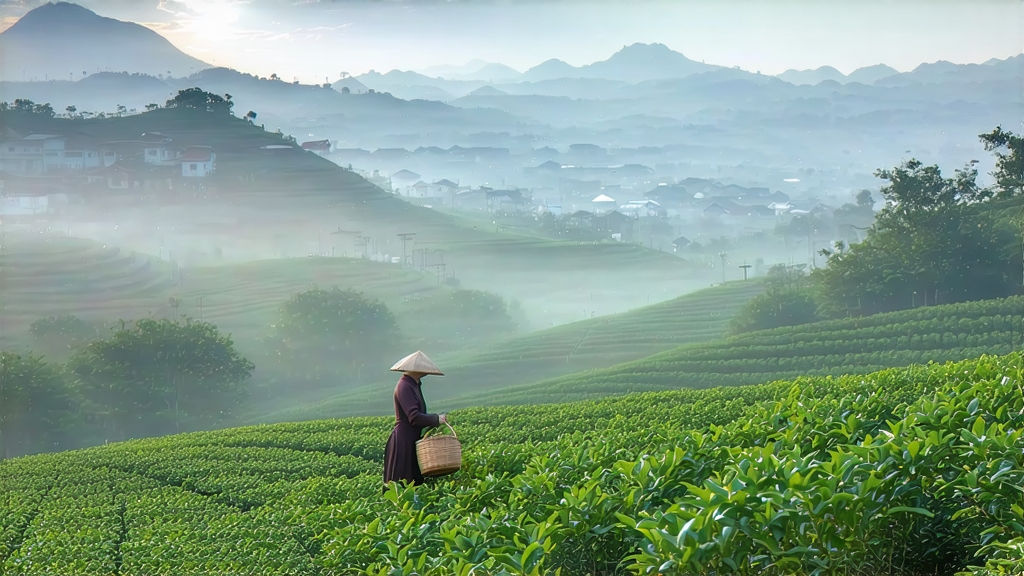
Tucked between the mist-laden cliffs of Dongting Mountain in Jiangsu Province and the vast, fish-rich waters of Lake Tai, Biluochun—literally “Green Snail Spring”—has captivated emperors, poets, and modern connoisseurs for more than a thousand years. Its tiny, spiral-shaped leaves may appear unassuming, yet they carry one of China’s most fragrant and nuanced green-tea profiles, a sensory bridge linking imperial court culture to contemporary tea bars in Paris and Melbourne. To understand Biluochun is to trace the Chinese art of coaxing aroma from the smallest possible bud, a craft that turns one leaf and one downy tip into a cup that smells of fresh orchards and tastes of alpine streams.
Historical whispers place the tea’s birth during the Tang dynasty, but verifiable records begin in the late Ming, when local growers around the village of Biluo offered an unusually fragrant pick to traveling monks. The Kangxi Emperor (r. 1661-1722), touring the lower Yangtze, sampled the infusion and rechristened it “Biluochun” for its snail-shell curl and early-spring harvest. Court chroniclers record that the leaf was so delicate it had to be placed in the emperor’s cup by ivory tweezers, a detail that cemented its reputation as “China’s most aristocratic green.” By the Qing, Biluochun had eclipsed Songluo and Longjing in price at the Suzhou tea markets, and European East-India captains risked pirates to secure chests labeled “Pi Lo Chun” for London salons.
Today the name covers a protected-origin zone of only 1,200 hectares on Dongting’s east and west peaks. Within that micro-zone, three distinct styles are recognized. “Mingqian West Peak” is harvested before the Qingming festival from 300-year-old seed-grown trees rooted in purple sandstone; it displays the highest concentration of floral volatiles and a silver-green down that floats like pollen on the brew. “Yuqian East Peak,” picked before the Grain Rain, offers a slightly stronger vegetal note and a brighter jade liquor, preferred in the Yangtze delta for daily “morning cup” culture. A third, modern “Lake Tai Terrace” style has emerged since the 1990s, planted on gentle slopes in hedged rows for mechanical picking; while it lacks the mountain tea’s complexity, its lower price has introduced Biluochun’s signature aroma to global blends and bottled iced-tea lines.
Creating Biluochun is a race against dawn humidity. Pickers—usually young women whose fingers fit the tiny baskets—start at 5 a.m. when the mountain air is still cool and buds are turgid with overnight dew. The plucking standard is fanatically strict: one unopened bud plus the adjacent leaf, no longer than 2.5 cm, must detach with an audible “snap” to ensure cellular integrity. A seasoned picker gathers barely 500 grams of fresh leaf in four hours, the quantity that will shrink to 100 grams after firing. Within thirty minutes the harvest is carried to the village’s communal courtyard, where three concentric bamboo trays rest above a chestnut-wood charcoal basin. Here the “killing-green” or shaqing phase begins, but unlike the high-temperature tumble-drying used for Longjing, Biluochun is pan-fired at only 80 °C while the craftsperson continuously rolls the leaf between palm and bamboo mat. This low-temperature coercion preserves linalool and geraniol, the molecules responsible for the tea’s apricot-and-narcissus perfume. After eight minutes the leaf is removed, allowed to breathe for two, then returned to the pan at 60 °C for the first “spiral rolling.” Thumb and forefinger twist the leaf clockwise, coaxing the iconic snail shape while rupturing epidermal cells just enough to release enzymes without oxidation. The cycle—roll, rest, roll—repeats three times, each drop in temperature locking in a stratum of aroma. Finally, the leaves are dried for 40 minutes over a 40 °C charcoal bed so gentle it can be touched without pain. The finished tea contains roughly 5 % residual moisture, low enough for year-round storage yet high enough to keep the downy hairs pliable and fragrant.
Western drinkers often brew green tea with boiling water and then wonder why bitterness dominates. Biluochun demands the opposite approach: cool, calm